

Return to VK3YE beginner and general articlesReturn to VK3YE antenna projects
|
HF portable the simple way
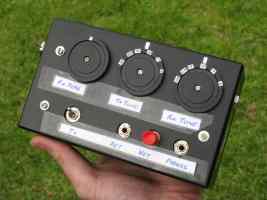 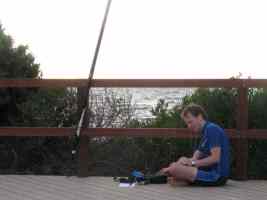
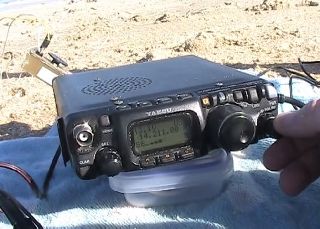
One of the most enjoyable facets of amateur radio is operating portable. You may live in an area plagued with electrical
interference, antenna space restrictions or dwell in an 'RF hole'. In such cases, portable operation gets you contacts not possible from home.
While not a substitute for proper RFDS or Marine equipment, amateur radio can add to the enjoyment of the trip on holidays and excursions. And the portable communications capability may be useful in emergencies.
Philosophy and Objectives
A weighty heading. But it's worth thinking about before you set off. Why are you going? What do you want to get out of it? And will the results be worth the chance of getting cold, wet, sunburnt or bogged?
I once did Field Day with a club where, despite the large number of helpers, it took hours to set up and dismantle the truly impressive portable station. Others spend months (and thousands of dollars) kitting out vehicles specially for portable use. There is no denying the effectiveness of such stations in earning high contest scores or setting microwave records.
Another approach to portable operating emphasises low cost, low power and quick setup. It won't win contests but there are other benefits. 'Minimum QRP', as I sometimes call it has a 'grab and go' spontanaety with little preparation or setup time required. And there's a certain beauty and satisfaction in getting good results from simplicity.
I also prefer HF portable over VHF and UHF. For several reasons. VHF and UHF are generally quieter and yield fewer contacts. And, especially on SSB, few progress much beyond a signal report. HF, particuarly the lower bands, is more congenial. My home location also plays a role; being a short walk to water but some distance from hills further adds to HF's appeal.
You may be different. If you're more technical, more elevated but less conversational, then VHF / UHF / microwaves may hold more interest. Long-distance VHF, UHF and particularly microwave contacts can make up in quality what they lack in quantity. This is especially if made on home-made equipment; something more common in the gigahertz range.
For this article I'll guess that you want to go portable, get on air and talk to a range of people. Right now it doesn't matter much where they are, but you do want to be heard and for there to be people around when you set up. HF is best for these purposes and is concentrated on here.
Location
If escaping interference or antenna size restrictions at home, any open area such as a park or beach will be worthwhile. However some sites are better than others for various reasons.
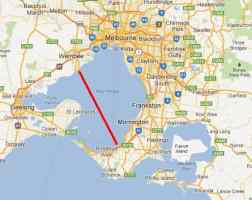 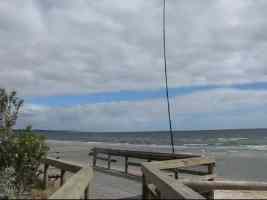 Things to think about when choosing a site include: * Availability of tall trees with branches in the clear (for supporting HF wire antennas) * Availability of fences or metal railings (for earthing and tying telescopic antenna masts to) * Sloping ground and/or water in favoured transmitting directions * Sufficient room to erect masts and wires without getting in the way of other users * Distance from power lines and other potential man made interference sources * General site amenity. Eg shade, shelter from wind and rain, decks/tables/seating, lighting, etc * Ease and availability of access. If driving, how near can you get to the favoured operating position? And if it's a park, do the gates shut at night? * Proximity to home The relative importance of these factors will vary according to the bands used, and the type and distance of contacts desired. If you're into DXing you may be willing to go for a further or less comfortable site if it means lower noise, better ground slope or water in the chosen direction. More on this later. Bands
You can often get by with just one band, though another one or two improves operating flexibility and range of contacts. Forty metres is a good all-round band where there's many hams within 300 to 1000km,
allowing contacts at most times. Add 20 metres if you're operating mostly during the day. 40 metres provides easy contacts up to about 1000km, increasing to 3000km around dusk. 20 metres
isn't so good for closer in but comes good over distances of 1000 - 3000km and worldwide for multi-hop. Antennas for both bands are easy to build and not too large.
At certain times and places other band come into their own. Examples include 80 metres (evenings), 160 metres AM (ground wave during the day), 10 metres (Summer sporadic E or DX openings) and 17 metres
(when there's a major contest on 20 metres). If you're up for a challenge, consider dawn or dusk greyline DX on the lower HF bands. More on the properties of various bands in the
Foundation guide to frequencies and at
QRP activity by band.
Antennas
A half wavelength of wire (20 metres on 40 metres or 10 metres on 20 metres) is the basic building block for HF portable antennas. Don't believe me? Jam a quarter wavelength of wire into your antenna socket and try to make contacts. You'll get some but adding another quarter wave to the transceiver's ground should improve results.
The main differences are how you support it, how you orient it and how you feed it. The method chosen depends on what's most convenient and the types of contacts desired. Below I describe the variants most useful for portable operating.
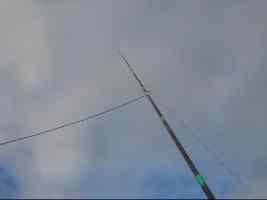
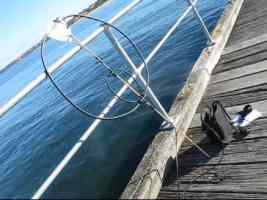 * Centre fed half wave horizontal dipole. Take your half wavelength of wire, fold it and cut into two equal lengths. Attach any length of feedline to the centre. String the antenna ends between two trees and have the feedline hanging down. If the feeder is coaxial cable you'll have an antenna efficient for one band and won't need an antenna coupling unit. Whereas with open wire the antenna will operate efficiently on multiple bands but will need an antenna coupling unit. The basic half wave dipole will perform well up to medium distances, with height an advantage for longer distance contacts. * Inverted vee dipole. Everthing's the same as the dipole above. The difference is that instead of hoping there's two trees spaced just the right distance apart, you support it at its centre. The ends are tied off to lower trees or fence posts. Again good for reliable HF contacts up to a few thousand kilometres, with longer distance DX very possible. * Vertical dipole Again the centre fed dipole is used unchanged. But this time you support one end from a high support so that the radiating element is vertical. The feedline must be brought off to the side, as near as 90 degrees as possible from the centre of the antenna. A vertical dipole is difficult to arrange on 40 metres as a 20 metre high support is needed. However they're much easier on 20 metres as only a 10 metre support (such as a lightweight squid pole) will suffice. Especially if used over a conductive ground, such as salt water, a vertical dipole will outperform a horizontal dipole for long distance contacts because of its lower angle of radiation. Because I normally operate near salt water, I've become a big fan of vertical dipoles for 20 metre QRP DXing. I should warn you that they can be noisy on receive, but this might be a signal that it's time to try a quieter location. * End fed inverted vee Here's where we ditch the bulky coax feedline and substitute a small L-match antenna coupler and short counterpoise. As its not supporting anything, the antenna wire can be the lightest grade of insulated hook-up wire. This lightness allows it to be supported on a telescopic squid pole - a huge advantage near the beach without trees. An end-fed wire of approximately 20 - 22 metres long and a 9 metre pole provides good local and medium distance results on 7 MHz. Because of the coupler it provides multiband capability. It will tune on 14 MHz as a 1 wavelength end-fed but doesn't seem to be as good as a vertical dipole for DX. Alternatives include forming it into a full wavelength loop on 14 MHz, or using the same loop split at the top as a bi square on 28 MHz. The end-fed inverted vee is highly recommended for local and medium distance portable work on 7 MHz and usable on other frequencies as well.
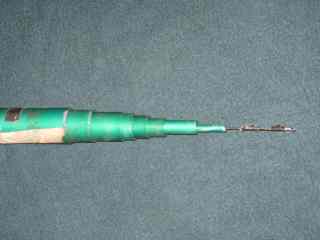
Generally the antenna should be mounted as high as possible. In most areas, it should be possible to find a suitable tree to support an antenna, though there are cases when it would be wise to bring a collapsible mast, for instance in the mulga or at the beach where there's few tall trees. Telescopic squid poles have been particularly successful up to heights of 9 or more metres. They will work with end-fed wire antennas if the thinnest type of plastic insulated wire is used to minimise pole bending. A 9 metre pole can easily support a span of 20 metres; adequate for 7 MHz and up. Light duty squid poles won't normally support even RG58 coax feedline unless it's run down the pole and taped to it every metre or two for support. Squid poles are too flimsy to support a VHF beam but they'll work with a lightweight antenna such as the 'hanging dipole' elsewhere on this site provided the feedline is taped to the pole. These poles have revolutionised amateur portable operation due to their low cost (under $50) and light weight. A suggested supplier in Australia is Haverford who ship nation-wide. There are other antennas suitable for portable usage (such as the loop pictured above) but those described are the simplest and most foolproof. More elaborate antennas are not needed unless space is extremely limited or gain is needed for DXing.
DXing
Portable DXing requires more than usual attention to operating location, equipment and antenna. I've mentioned before the advantages of water. Ideally the water needs to be between you and the direction from which DX signals are arriving. While you can't tell this without a beam, 14 MHz afternoon signals from Europe commonly arrive via the long path. This means that from south-east Australia it may be better to operate from a beach facing south-east than one facing north-west.
My own experiences have been consistent with this, with better results from south-facing beaches of Stony Point and Altona than those in other directions. As demonstrated by Les Moxon G6XN, the use of hills sloping towards the desired direction is another way to exploit location. Moxon found that low dipoles were sufficicient to achieve outstanding results with low power. Both 'salt water' and 'sloping ground' approaches are illustrated below.
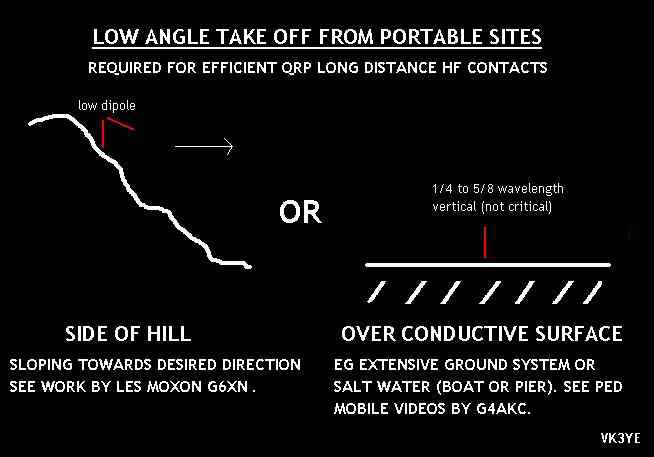 While being beside water is good, an antenna over water is even better for the lowest radiation angles and best DX. Without a boat this is best done by setting up on a pier. Piers are often narrow and crowded when the weather is good. Try to make your station as small as possible to avoid inconveniencing others. Ways to do this include vertical antennas (such as the suggested squid-pole supported vertical dipole), compact equipment and small batteries. Using good antennas further improves portable DX performance. Superior to the vertical dipole is some sort of beam. Height is important for horizontal beams at home but when there's salt water around you can do well with a low vertical beam. Size and weight are the biggest challenges, especially for prime sites in remote areas where things need to be hand-carried. I have found that a vertical Moxon a good performer on 20 metres, with its dimensions just small enough to fit onto two 9 metre squid poles.
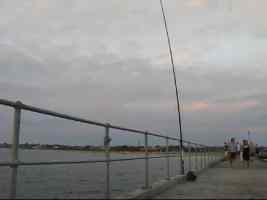
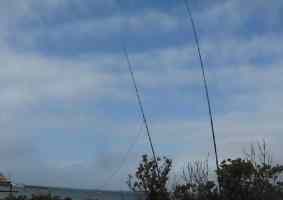
The log below, from April 2012 shows what can be achieved with QRP from Somers on Westernport Bay, south of Melbourne. Contacts before 0600 were made with a vertical dipole on a squid pole. Contacts after then were made with a 2 element vertical Moxon in a slightly different location further from power line noise.
A good way to measure DX success is to look at what stations your contacts are using. If you're only working kilowatt stations with 6 element yagis, it means your signal must be marginal for all but the best stations in the best locations. Improvements to your station are measured by an increasing percentage of contacts working you on their smaller beams, verticals and dipoles. And hearing DX QRP stations must says something about your location, antenna and receiver as well.
Equipment and modesAny 12 volt-operated transceiver can be used portable. However some rigs are more suitable than others. Multiband HF commercial rigs perform well enough for performance not to be a major deciding factor on what to use. Instead usefulness for portable operation depends more on factors such as small size, light weight, low power consumption and ease of operation. While major commercial manufacturers built transceivers for use in vehicles even before they became 100% transistorised, they were slow to adapt their designs to the smaller size and low power consumption required by backpackers and hikers. Those wanting such rigs had to build their own, with single band direct conversion CW-only designs being popular.
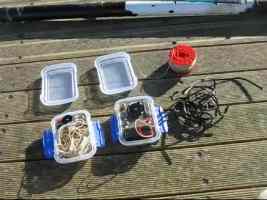 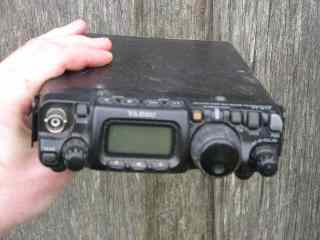 Yaesu was the first mainstream manufacturer to bring out a very small portable multiband transceiver with the FT-817 (pictured above) weighing about a kilogram. Launched in 2001, it featured 160 to 70 centimetre multimode coverage and a 5 watt output power. Icom responded with the bulkier and lower coverage 10-watt IC703. While a major step forward for short term portable operation, the FT-817 does not satisfy everyone. Not everyone needs its band coverage and features. And some would have preferred a lighter weight and less fiddly knobs. Although it draws less than bigger equipment, the FT-817 is still a power hog on receive. Its 300 mA receive current consumption compares unfavourably to the 30 to 60 milliamps for more basic receivers. Since most time is spent listening and batteries are heavy, high receive current consumption is a major impediment to backpacker-style lightweight operating. Then there's what's jargonishly called the equipment's 'form factor'. The true minimum portable QRPer carries as little as they can get away with. They are most unlikely to bring a chair and table. Instead the operator sits on the ground, a rock or available seating. Using or seeing the FT-817's tiny display requires the user to inconveniently crouch down or tilt it up. Operating is made easier if a rig's controls are on top. This is what Americans call the 'trail-friendly radio'. Other TFR features include low receive current consumption, physical ruggedness, easily adjustable controls (even with frozen, gloved or sweaty hands) and sufficient earphone audio output for use on a blustery day. TFRs are not new. Suitcase radios that opened up to reveal a top control panel were used in WWII. Rugged Australian Codan portable SSB transceivers for outback use stood on their rear, with the front panel pointing up. The large amateur equipment manufacturers have not showed interest in what is a niche market so have left the field to home constructors, and, more recently smaller commercial makers. Commercial and homebrew TFR attempts are pictured below.
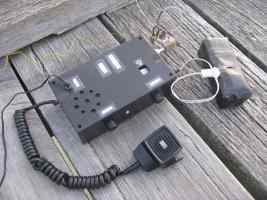 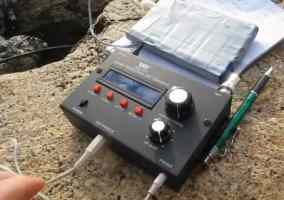
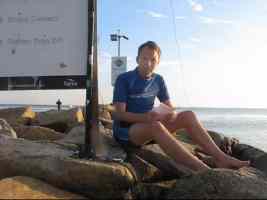 Is there such a thing as too much simplicity in homebrew equipment? I believe there is, especially when operating portable. I discuss this elsewhere but the main point is that crystal control is only good for fruitless calls and few contacts. Key to successful QRP operating is finding and calling other stations instead of hoping they find and answer your weak signal. For this frequency agility, either through a VFO or good VXO, is essential. Then there's output power. I've entered HF field days with less than 100 milliwatts output on SSB. But if you were to increase power to five or ten watts the proportion of stations hearing you increases dramatically, from about 10 to 80 percent. If choosing a transmitter to build, pick something between about 2 and 5 watts, at least for a first project. Receivers can also be stupidly simple. Very basic receivers, such as contained in the bare-bones Pixie QRP design, work but aren't recomended. What barely suffices in a quiet shack with a resonant coax fed dipole will be unsuitable for use outside with noise from wind, waves and people. Good portable locations also mean stronger incoming signals that can overload the receiver and blot out desired signals. A well built direct conversion receiver is acceptable for 160, 80 and 40 metres. However if over 3000km DX is desired on 20 metres, a single-signal superhet receiver (preferably with a narrow filter) is much preferred, especially if working lower power stations. Operating a rig that requires several switches and a tuning adjustment to be reset before transmitting isn't that convenient when at home. However it's positively unpleasant when portable, especially when it's hot, cold, windy or rainy. The niceties that homebrewers often leave off (I'm as guilty as anyone) really ought to be available in a portable rig. The most important of these are efficient (preferably automatic) transmit/receive switching and, for CW rigs, an automatic transmit/receive frequency offset. Buoyed by the availability of proven designs and kits (like the BitX) an increasing number of builders are trying voice rigs. SSB and DSB are both recommended; the latter being slightly less efficient but much simpler to build equipment for. Single band transceivers much easier to build than multiband rigs and their low receive current consumption gives them an edge over commercial rigs. 40 metres is a good band to start due to its high activity and quality contacts obtainable, at least in south-eastern Australia. 20 metres though is more of a gamble; it provides the satisfaction of 15 000 km plus DX contacts but making them is harder work than the typical 40 metre ragchew. Simple AM transmitters can be rewarding for 160 metre portable work with sufficient local activity and a handy location across the water from most stations. Alternatively, if near a park with oval, its metal fence railing can form an extensive and efficient ground. Otherwise, simple homebrew AM transmitters are a false economy and are not recommended for portable use due to their inefficiency and high battery drain. Low power 80 metres AM during the evening is particularly unusable due its chronic phase distortion and the much clearer DSB and SSB modes are much preferred. Digital modes offer a different brand of portable operating. These include keyboard chat modes (such as PSK31) or beacon modes like WSPR. Keyboard chat modes can be more efficient than SSB. Their downside is that they usually (but not always) require a computer. With its screen and keyboard laptops tend to be less robust in the wind, rain and salt than a covered transceiver. These factors plus my aversion to carrying more than needed are the main reasons I rarely operate digital modes portable, though they are undoubtedly excellent choices for business trips where a laptop is often carried. WSPR (Weak Signal Propagation Reporter) is another computer-assisted mode. It is most suitable for the patient with a good book or something to do on the computer. A simple WSPR transceiver of the type developed by W3PM for portable use is significantly easier to build than your typical SSB voice rig. WSPR is particularly useful if you are able to check report from other stations in almost real time on your web-enabled phone. This could make it a powerful tool when testing portable antennas as the dB signal strength readings obtained are more reliable than signal reports. Apart from that it's not a conversational mode unlike the others discussed.
Power sources
A few portable location have access to mains power, though this cannot be assumed. Batteries, sometimes assisted by a solar charger, can run a low power station for hours.
Battery types can include nickel metal hydride, sealed lead acid and lithium poymer. Higher power portable operation may require a petrol generator. Apart from the extra bulk and weight, generators are unsociable near other people (eg on a pier) and may not be allowed in national parks due to their fire risk. Problems in obtaining power are one of the main reason why a 'minimum QRP' approach is often easiest when operating portable for any length of time.
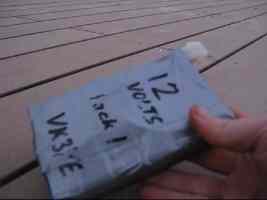 The power source eventually adopted depends on:- * The period of portable operation * Transceiver current drain * Size/weight considerations Portable operators find that there is a trade off made between operating period/transmit power output on the one hand, and battery capacity/size/weight on the other. Your need for transmit power depends on the results desired. On HF, running between 2 and 20 watts on SSB should suffice for most short and medium distance work. Between 14 and 28 MHz DX should also be quite possible with such low powers, especially if combined with a good location and antenna. Above that you reach a point of diminishing returns as power requirements multiply for little improvement in the quality of contacts made. Either rechargeable sealed lead acid batteres ('gel cells') or Nickel Metal Hydride battery packs are reliable and cost-effective power sources for portable operating. Somewhere in the 4 to 7 amp hour range will provide several hours of running 5 watts CW or SSB. I've never used solar panels to top up (one more thing to take!) but they look promising if you'll be away from mains power for several days, given their falling prices. If you're not sure about power requirements, it makes sense to draw up a power budget so that you know approximately how long your battery will last. Transmitting demands more from the battery than does receiving, with the difference increasing with transmit power. Different activities have differing transmit:receive time ratios. For instance, one-to-one operating is more power intensive than a large net with many on frequency. To draw up a power budget, you need to know the following:- * Transmit current consumption * Receive current consumption * Transmit:receive ratio * Battery capacity (in amp hours) The first two can be obtained from your transceiver's instruction manual. The battery's capacity should be printed on the battery itself, while you can take a guess for the transmit:receive ratio.
We will use an example here of a Yaesu FT-817. Its transmit power consumption is 2.0 A, while on receive, we'll allow 0.4 A (at 13.8 volts). We assume that we will be listening twice as long as we're transmitting (ie transmit:receive ratio of 1:2). Thus in an hour one would be transmitting 20 minutes (0.33 hr) and receiving 40 minutes (0.67 hr). The object of this exercise is to find the mean power consumption of the station in a given hour of activity. Armed with this information, one could then determine how long a particular battery is likely to last, or, conversely, how long one can operate with a battery of a given capacity. A calculation for the FT-817 would be as follows:- Receive contribution:- 0.4 A x 0.67hr = 0.27 A.H Transmit contribution:- 2.0 A x 0.33hr = 0.66 A.H Total (for 1 hour):- = 0.93 A.H If we were to operate in this manner for one hour, about 1AH of battery capacity would be needed. With 2000 mAH batteries (eg NiMH AAs), it should just be possible to operate for about two hours. Note that this does not take into account any deterioration in battery capacity with age so it would be wise to plan for 50 to 100% more battery capacity than needed, ie a 3000 to 4000 mAH battery pack. Supposing you could cut receive power consumption from 0.4A to 0.1A. The receiver's contribution would fall from 0.27 to 0.07 AH, reducing the total to 0.73 AH. This is a better than 20% increase in power economy (and thus charge life) with an unchanged transmitter output. And with a more normal (ie lower) transmit : receive time ratio the power saving is even greater. The message is that receivers contribute significantly to overall power use and transceiver makers need to cut consumption for their product to be genuinely suitable for portable work. Then there's the transmit side. Assuming efficiency is the same, doubling transmit power doubles current consumption and halves operating times. Unless signals are marginal or contacts are kept very short, this is a poor trade-off for a not always noticeable 3dB improvement. In the real world though a transmitter's efficiency is rarely the same at various power levels. A 100 watt transceiver set to 10 watts output will draw much more than one tenth the current it takes at maximum power and its efficiency will be much lower than near full rated power. For this reason (and others such as their bulk and high receive current use) it is not wise to use a 100 watt rig turned down low in situations where power needs to be saved. Instead it's better to use a dedicated 5 or 10 watt radio operating near its rated output and thus at peak efficiency.
|
Books by VK3YE
Ham Radio Get Started (USA)Australian Ham Radio Handbook (Aust) More Hand-carried QRP Antennas 99 things you can do with Amateur Radio Getting back into Amateur Radio Illustrated International Ham Radio Dictionary Make your Passion Pay (ebook writing)
All material on this site |